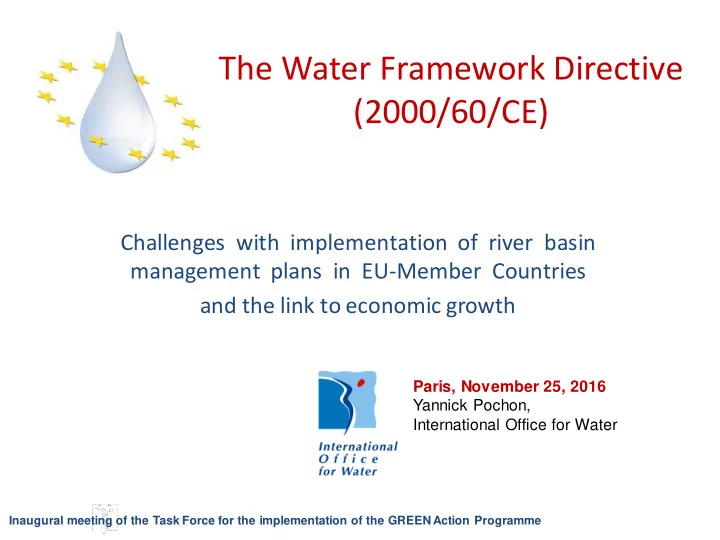

The Water Framework Directive (2000/60/CE) Challenges with implementation of river basin management plans in EU-Member Countries and the link to economic growth Paris, November 25, 2016 Yannick Pochon, International Office for Water 1 Inaugural meeting of the Task Force for the implementation of the GREEN Action Programme
The WFD: a major text for water policy More than 30 European directives concerning water Before A sectorial approach fight against some substances (Dangerous substances directives, Nitrate directive, …) standards and regulation by use (potable water, bathing, …) Upcoming abrogation of several With the directives WFD A main objective : protection of aquatic bodies and of water ressources 2
Panorama of European Directives From a sectorial to an integrated approach 98/83/EU and 80/68/EEC « drinking water » Daughter Directives 79/869/EEC of 76/464/EEC 96/61/EEC « IPPC » « shellfish waters » * 80/68/EEC 91/676/EEC « nitrates » 78/659/EU « waters supporting fish life » * « groundwater » * 91/271/EEC « Urban 76/160/EEC « bathing water » 76/464/EEC Waste Water » 75/440/EEC « surface water « dangerous intended for the substances » * abstraction of drinking water » * Quality of Discharges WATER FRAMEWORK DIRECTIVE Aquatic body 2000/60/EC Directive Directive Directive on Habitats’ Birds’ concerning the concerning the major directive use of plant evaluation of the directive accidents 92/43/EEC protection environmental 79/409/EEC (Seveso) products impacts 96/82/EC 91/414/EEC 85/337/EEC 3 * Directives to be repealed by the Water Framework Directive
WFD leans on confirmed or reinforced principles • Management by hydrographic districts/basins • Planning cycle on the horizon 2015, 2021, 2027 • Protection of aquatic ecosystems and terrestrian ecosystems which depends directly from • Economical analysis (new) • Public participation (new) 4
3/2005 Art.15 3/2007 Art.15 3/2010 Art.15 Report Report Report 12/2003 Art.3 12/2006 Art.8 12/2009 Art.11 12/2012 Art.8 GOOD STATUS Transposal Monitoring programme Programme of measures Common approach 12/2015 Art.4 2000 Art.24 WFD 2000 2003 2004 2005 2006 2007 2008 2009 2010 2011 2012 2013 2014 2015 Art.6 12/2004 Art.9 12/2010 2021 Pricing policy Protected areas register Art.5 12/2004 Characterisation of RBD Art.13 12/2009 2027 RBMP Deadlines and objectives 5
Some Objectives and obligations of results Environmental objectives: • Reach the good status of surface waters (ecological and chemical) and groundwaters (chemical and quantitative), • No deterioration , • Objectives to reach in protected areas , • To suppress the discharges of prioritary dangerous substances in 20 years and et to reduce e missions of prioritary substances 6
Urban Waste Water Directive • Collection and treatment of waste water in urban settlement areas, incl. economic activities, (agglomerations) of > 2000 population equivalent • Transitional deadline for implementation, including interim targets, currently applicable in 13 EU-MS • Performance monitoring of treated waste waters • Industrial waste water: 1) => pre-treatment of industrial waste water discharged into public network (where necessary) 2) => UWWTD covers 11 industry sectors with biodegradable waste water 7
Implementation of UWWTD – state of play • Very high compliance rates in EU15 , frequently in the range 95-100% • Significant progress in EU13 , but results still much lower (e.g. in SA) • EU funding helped implementation: Between 2007-2013 17,8 billion euro investment support from EU funds, but better use of implementation programmes is needed • Attention to be paid for big cities (> 150,000 p, almost 600 in EU): 89% of its load received more stringent treatment than required, however, degree of compliance varies significantly (e.g., in capital cities) 8
Economical aspects 9
Main outcomes • 2027 ? • The “ one out all out ” principle prevents to show the real progress achieved in improving the state of the water bodies, and that is direly needed to justify investments to the public and the decision-makers in a context of strong budget constraints. • More generally the question of communication on progresses already achieved (by MS and by COM) must be tackled 10
Praising WFD’s strengths and lessons learned … : • WFD brought 28 EU Member States to adopt the right approach and tools to improve the states of the water resources and this shouldn’t put in jeopardy. • Among the key achievements made thanks to the WFD: greater coordination (between administrations and sectors), broader application of the cost recovery analysis, stronger monitoring networks and Water Information Systems (WIS) for data management, wider involvement of the stakeholders and the public • Many developments of tools and methods at basin, national or european level 11
Establishment of a Peer-Review Mechanism 12
Challenges and perspectives • Many lessons learned from 2 first RBMPs • Limits already identified for some methods and implementation • Changing context (SDG, CC, Economic crisis … ) • A cautious approach for the 2019 review, as WFD shouldn’t result in a loss of ambition or in a loss of accountability • The framework and integration spirit of the WFD must be kept 13
Perspectives Integration with other directives and policies : Nitrates, CAP, Green growth and innovation, Circular economy package Re-use … • 14
Thanking you for your attention Paris, November 25, 2016 Yannick Pochon, International Office for Water y.pochon@oieau.fr 15
Recommend
More recommend